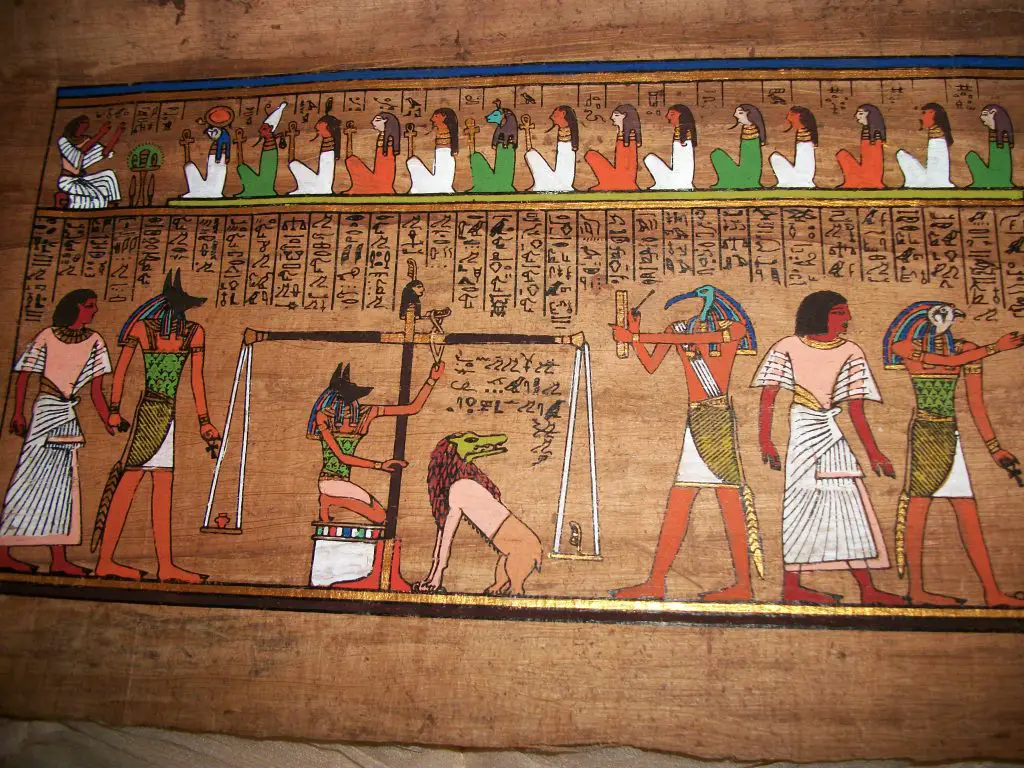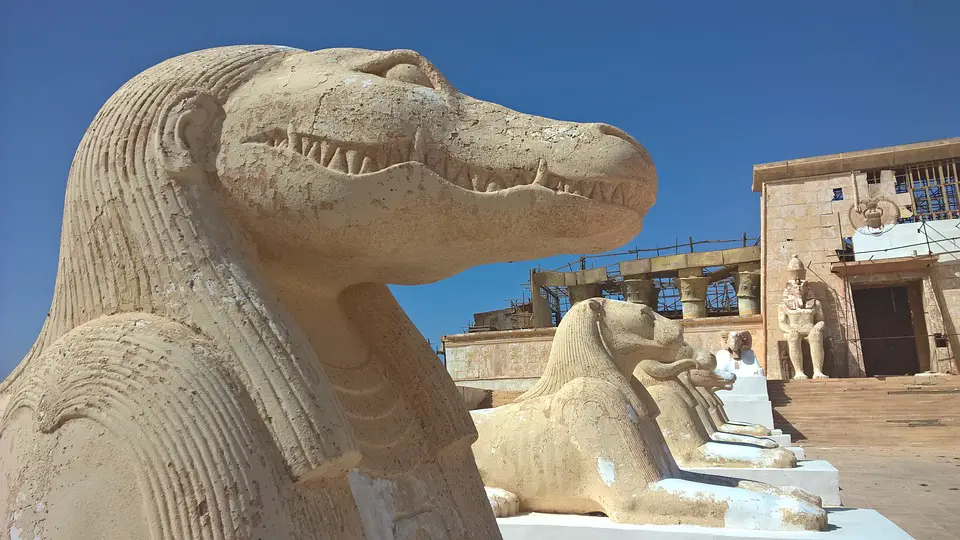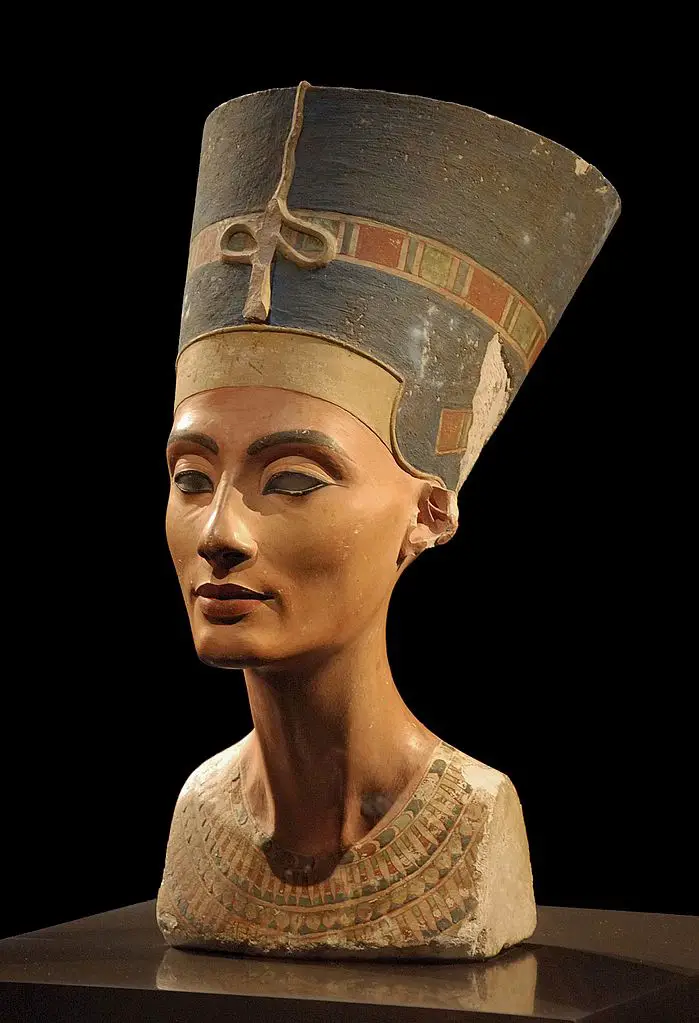Why Is Acinet Egypt Are Inportant Egyptian Art History
Ancient Egyptian art has provided us with tons of information nearly Aboriginal Egyptian civilization.
It's given scientists and scholars clues about what Aboriginal Egyptians looked similar, what activities and jobs they did, what was of import to them, what vesture they wore, and more than.

Colors and Materials
Aboriginal Egyptians used six colors in their art: white, black, red, yellowish, green, and blue. These colors, or pigments, came from local minerals.
To make pigment, Ancient Egyptians ground the minerals into a pulverization then mixed them with a plant or animal-based glue, and then they would stick to surfaces like walls.
Although they didn't use many colors, Ancient Egyptians did use a variety of materials.
Artists created their work with stone, wood, ivory, limestone, copper, bronze, gold, silver, and even lapis lazuli (a beautiful blue stone).
Types of Ancient Egyptian Art
Ancient Egyptian artwork included:
- Sculptures
- Painting (peculiarly on tomb walls)
- Relief
Sculptures
The Aboriginal Egyptians creating many famous giant sculptures, ordinarily of gods or pharaohs (who were considered very powerful and god-like).
Giant sculptures can be institute at pyramids, in temples, and sometimes in Aboriginal Egyptian palaces.
Their giant sculptures are most famous, simply Ancient Egyptians created smaller sculptures too. The pharaoh Tutankhamen'south funerary mask is one instance.
Information technology was made from blue drinking glass, semiprecious stones, and 24 pounds of solid gold! Other sculptures were created from limestone, woods, ivory, basalt, alabaster, and other materials.

Painting
Nigh Ancient Egyptian paintings that survived to mod times were found on tomb walls. The Ancient Egyptians believed that these paintings could assist people in the afterlife.
Many of the paintings show people with their loved ones, passing into the afterlife, or feeling happy in the afterlife.
Relief
A relief is a sculpture carved into a wall or other structure. Ancient Egyptians frequently carved them into the walls of tombs and temples.
They would make the carving, smooth the surface with a layer of plaster, and so pigment it. Some elements might only exist painted and not carved.
Characteristics of Aboriginal Egyptian Art
In most societies, art changes and evolves over time. But in Aboriginal Arab republic of egypt, the art remained mostly the aforementioned for over 3000 years. Characteristics of Aboriginal Egyptian paintings included:
- People drawn larger based on social status. For example, if a pharaoh was in a painting, he was e'er larger than any other person in the analogy.
- Pharaohs are likewise illustrated equally serious and formal. Other people appear more natural and relaxed in Ancient Egyptian paintings.
- Paintings are always drawn ii-dimensional, or flat, with no depth perception.
- People in Ancient Egyptian paintings are almost ever seen in profile, or from the side.
Ancient Egyptian sculptures shared characteristics such as:
- Figures facing forwards
- Figures very formal and upright, whether they were sitting or standing
- If sitting, figures had hands on their knees.
- Sculptures of males are always darker than sculptures of females.
- Realistic human faces

Purpose of Ancient Egyptian Art
What's interesting well-nigh Ancient Egyptian art is that nearly of information technology was never meant to be seen. Their artwork had a dissimilar purpose.
The Ancient Egyptians were very religious, so most of their artwork had to practise with faith. This is why artwork is institute in the temples, in tombs to guide people to the afterlife, and in the palaces of pharaohs, who were considered god-similar.
Statues of gods were often the subjects of religious rituals. Statues of royalty and other elites were seen every bit messengers between people and the gods.
Aboriginal Egyptian fine art was about more beauty. Information technology was meant to serve a purpose that benefited someone—usually gods, royalty, or the dead.
Fun Facts About Ancient Egyptian Art
- Aboriginal Egyptian art almost e'er included text. On statues or sculptures, text often appears on the base or back colonnade identifying the field of study. Relief usually has captions explaining the scene.
- One reason Ancient Egyptian art survived then long is Arab republic of egypt's dry climate. Nevertheless, most of the fine art in the tombs was eventually stolen past thieves.
- Aboriginal Egyptians used a lot of symbolism in their artwork. For example, beetles represented transformation, while hawks represented wisdom.
- Fifty-fifty colors symbolized meaning: light-green was new life, red was victory or rage, black represented expiry and resurrection, yellow was eternity (since the sun is yellow), white represented potency or purity, and so on.
- Aboriginal Egyptian craft included jewelry, pottery, and tapestries. Jewelry often featured nature symbols similar garlands of flowers and fruit.
- In Ancient Egyptian paintings, scenes were displayed in horizontal rows chosen registers.
More Ancient Arab republic of egypt facts.
harrisonequesions.blogspot.com
Source: https://savvyleo.com/world-history/ancient-egypt/art/
0 Response to "Why Is Acinet Egypt Are Inportant Egyptian Art History"
Post a Comment